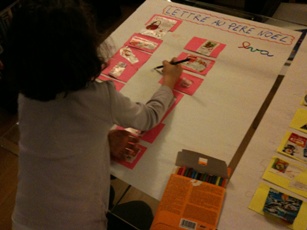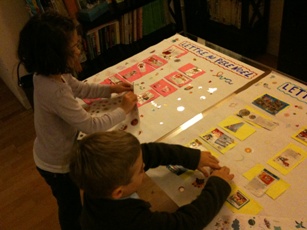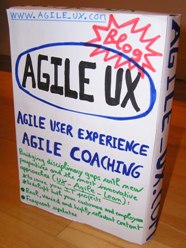Posted by jc-Qualitystreet on 2010/12/10
First article dedicated to the responsibilities of the Agile manager, who has a major role to play in the agile adoption. At a time when the era of management 3.0 (a lean and agile management) is announced, the role manager is evolving, between opportunity and necessity
#1 Initiate and support communities of practice… which means
- Give time and resources to agile communities, ScrumMaster, Agile coaches, Product Owner, Agile Testers, Architects, UX Groups …,
- Give feedback on what is done by the communities of practice
- Promote agile communities of practice in the organization
- And why not participate and animate some communities (in a role of coordinator)
Communities of practice are an essential feature of the agile transformation programs we undertake. They are the perfect illustration of the « Yokoten » technique (the horizontal transfer of information and knowledge across the enterprise) used by Lean practionners.
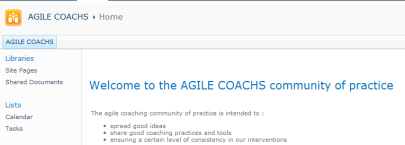
Agile coaching Community of Practice
What is a community of practice?
« Communities of practice are groups of people who share a concern or a passion for something they do and learn how to do it better as they interact regularly. » Etienne Wenger
The idea is not new, but makes sense now, at a time when companies are reconfiguring to become agile, and seek to increase the number of their dedicated, CROSS FUNCTIONAL and self-organized teams. Communities of practice are aligned to this purpose and enable to:
- Exchange on current practices
- Deepen knowledge and expertise
- Spread good ideas, practices and tools in the organization
- Bring together people across teams or product lines
- Coordinate and ensure the necessary consistency between the teams
Our community of practice is not a facebook like!
Its identity is built around the common interest for a specific DOMAIN and the willingness to learn. Passion, learning and commitment are the foundations of the community of practice. For example, I voluntarily belong to the « Agile Coaching » community of practice… because I am an agile coach, highly interested in the topic. But also because I want to contribute, share and discuss with other coaches (experienced or not). And, of course because I want to improve my own PRACTICES.
The same for the ScrumMaster… sometimes feeling alone, isolated within the team, he often needs to challenge himself and wants to discuss and share with the other ScrumMasters of the organization… The community of practice is primarily PRACTICES-ORIENTED, and focus on lessons learned, problems, solutions and vision. The community of practice is collective, dynamic, and collaborative. Members help each other and share information with a COMMUNITY mindset.
And the agile manager?
Communities of practice are not intended to appear in organizations chart. But even if they remain informal, they have a strong need for recognition and support.
Thus the role of the manager is crucial to face the five main challenges (organizational, managerial, community, personal and technical) related to the establishment of such communities in the company. Setting up new rules in the organization to facilitate the communities is often needed. The agile manager will also have to encourage and motivate people to participate, give feedback and handle the technical and logistics aspects to enable communities to express themselves online… and face to face. Because building a community of practice also requires solid relationships between the members, meeting physically and regularly is necessary. It has a cost and must be prepared. The openness of the community towards the outside of the company is also an important point of discussion with management.
At last, enabling the communities of practice to succeed and to flourish in the organization requires the recognition from HR and management of new collaborative skills among communities’ members. A community of practice is collective game.
For both the organization and the individual, the community of practice is the opportunity for knowledge capitalization and improvement. The communities of practice are highly valuable … and this is the responsibility of the agile management to support and develop them!
Posted by jc-Qualitystreet on 2010/12/05
But also a necessity!
The era of agile and lean management (see Management 3.0: Being an Agile Manager) is announced, and many factors contribute to the awareness and the birth of a sense of urgency that can serve as a starting point of willingness to change to lead middle managers to become agile managers.

The Agile Manager: Leadeship & Facilitation
The Enterprise environment
Fast, complex, competitive, changing, the external environment impacts the company itself. Pushed to review its governance, processes and valuable assets, the organization must also differentiate itself from its competitors in terms of knowledge, information sharing, skills and career management. The agile and lean enterprise is an obvious answer to these challenges, and middle managers, first line for these activities, have a major role to play. Whether supporting or opposing, they will be highly impacted by the fundamental changes introduced by an agile and lean approach.
The Rise of agility
Agile methods have spread into projects and in the everyday business life of people. Very popular in IT projects, agility is now everywhere and difficult to avoid. Managers can’t ignore it anymore. Moreover to understand what people actually do and how IT teams work, middle management will require the appropriate level of agile information and training… first steps toward change?
Concrete and visible results
It’s also difficult for middle management to ignore the benefits provided by Agile methods. Agility enables organization to reduce time to market, to improve product quality, to increase project visibility and productivity. Better team satisfaction and better end-user satisfaction are also observed. Agile methods have shown their efficiency and proved that it worked. Ten years after the Agile Manifesto, birth of Agility, agile and Lean practices continue to spread at a « unsustainable » pace 🙂 With the appropriate level efforts, an agile and lean approach gives fantastic results. So, why not applying some of these good practices and using them as a source of inspiration for management activities?
People expectations
Of course some needs and expectations of working people (achievement, recognition, empowerment…) are not new but the agile mindset is! An agile mindset grows within team members working with agile methods, and changes their relationship with others, with work and with their company. Collaboration, courage, feedback, simplicity and respect, the fundamental agile values are now also expected outside of the agile team, and primarly with middle management and hierarchy. Trust and feedback will be the keys.
From a generational point of view, the rapid growing of digital natives (people born after 1978) inside companies also changes the face of the enterprise and how the businesses operate. Digital natives need real time interactions & collaboration, networks, communities and a new management style. Once again, I have the feeling that agile management is a very good option to address the needs of this specific population.
HUMANITY, FACILITATION, COLLABORATION and LEADERSHIP seem to be the key characteristics of the AGILE MANAGER. And inspiration can be easily found in these few principles of lean management:
- Base your management decisions on a long term philosophy… even at the expense of short-term financial goals
- Grow leaders… who thoroughly understand the work, live the philosophy, and teach It to others)
- Develop exceptional people and teams… who follow your company’s philosophy
- Respect your partners and suppliers... by challenging them and helping them improve
- Go and see for yourself… to thoroughly understand the situation
- Make decisions slowly by consensus… thoroughly considering all options implement rapidly
- Become a learning organization... through relentless reflection (Hansei) and continuous improvement (Kaizen)
Posted by jc-Qualitystreet on 2010/11/21
Agile development and user experience can work brillantly together… well, but how?
Even if the effort related to Agile User Experience (Agile UX) continues throughout the project (with « just in time » designing and user testing) the User Experience foundations must be initiated at the very beginning of the project, during the first sprints.
Starting to define the Product vision is a best practice. Key element of the vision, the PERSONAS (a fictional representation of target users you can use to help guide decisions about product, features, navigation, visual design…) have also the precious advantage to be directly linked to USER STORIES (brief description of functionality as viewed by the user and an essential agile artifact).
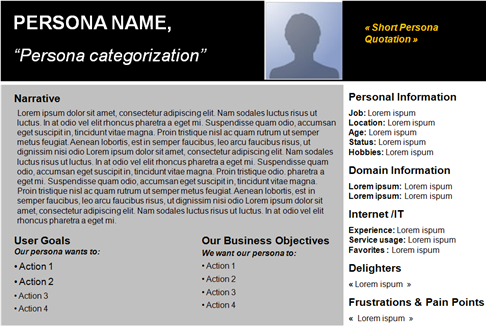
A persona template
First sprints are also the best moment to create a coherent vision of the User Interface structure, and to establish first Usability guidelines (then UI patterns), two elements that will enable UX specialists to maintain a consistent user interface across features and regular deliveries.
Once the product vision and posture established, the target users defined and the product backlog (list of all functionality desired) initiated, user experience of the application will continue just in time, sprint after sprint, following the iterative and incremental lifecycle.
Trust and collaboration are the keys, and UX practitioners MUST BE collocated with development team: visual artifacts, storyboards, mockups and wireframes, will serve the project and enable business and development teams to build the best user experience.
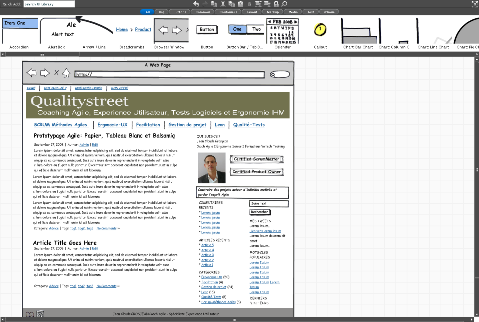
Wireframe with balsamiq: quick, easy and collaborative
But agile development lifecycle proposes new challenges and requires managing User Experience differently…
Practice #1
Support user representatives or business teams (Product Owner) in their analysis, specification and prioritization effort…
UX specialist is the user advocate but also Product Owner partner as well as a team member.
Practice #2
Do just enough user Research, user modeling and UI design up front
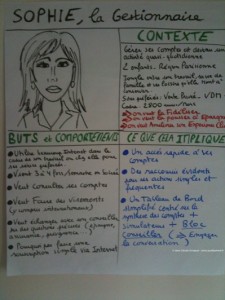
The Agile Persona : quick and easy
Practice #3
Adapt your collaboration with teams during a sprint:
- Progress one step ahead of the implementation by preparing and designing « just in time » contents of next iterations (sprint+1, sprint+2)
- Collaborate actively with developers on the functions that must be delivered at the end of the current sprint
- Evaluate with end users results of the previous sprint (sprint-1)
Practice #4
Consider feedback differently: direct, less formal, more frequent and more reactive both in the way to receive and to give it. Overuse face to face collaboration, guerilla usability testing and just enough reporting & documentation
Practice #5
Use rapid prototyping (effective wireframes) to foster collaboration and elicit rapid feedback. Make it valuable and adjusted to the context
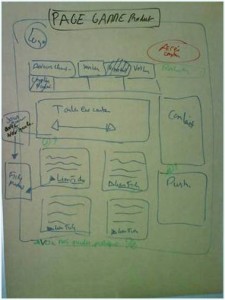
Paper prototyping ... from collaborative workshop
Practice #6
Be a facilitator and engage people (both business, development and end-users) on collaborative workshops to design and evaluate the system
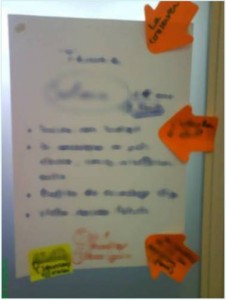
Persona workshop
Anything else ?
Posted by jc-Qualitystreet on 2010/11/15
During an agile transition program, do not let your managers by the roadside! Rather help them to become Agile managers and to control the evolution of their profession.
The « era of management 3.0« (agile and lean) is announced so make the middle manager a key player for change, between opportunity and necessity…
The case of middle management
« Top-Down » or « Bottom-Up », there is no debate anymore. We know today that a top management support and the ownership by the teams are both essential to ensure the success of the transition to agility. No, the issues of the Agile Enterprise are now in intermediate managerial layers of the organization.

Towards an Agile Middle Management
How to approach them? How to convince them? How to transform them?
My experience with Agile projects and agile coaching in various sectors (banking, industry, software vendor …) showed me that this is the middle management that holds the keys to agility on the Long Term. Indeed, middle managers can be the most active supporters or the worst impediment and therefore the most dangerous opponent of the agile transformation.
The opportunity to become an Agile Manager…
With only one goal: the success of teams…
The « Command & Control » management style based on Taylorism and scientific management (OST) has shown its limits… the agile manager explores new dimensions (mostly related to facilitation & leadership) to ensure the success of all. The role within an agile organization becomes a clever trade-off between maintaining / abandoning some responsibilities and acquiring new skills.
So, even if every management role is unique, context-specific, here is the list of the 6 core activities of the Agile manager:
- (Still) Manage the portfolio of projects and coordinate with other managers
- Define projects strategy at the organization level
- Set priorities
- Define budget and resources
- Do the staffing
- Work with peers as a team
- (Still) Manage recruitment
- Hire people
- But also fire and solve potential conflicts
- Support Projects and Agile self-organized Teams
- Promote autonomy and self-organization
- Remove impediments that the team or ScrumMaster are not able to manage
- Manage logistics
- Buy the supplies
- Challenge teams and help them to improve their knowledge about products, tools, technologies, methods…
- Create a relationship of trust, develop (career) and motivate people
- Make yourself available
- Get to know each person and his work
- Facilitate the acquisition of new skills
- Give feedback
- Give work recognition
- Delegate tasks
- (Still) Create an environment for success and energize change
- Communicate the vision
- Give a direction
- Adopt the appropriate management style
- Simplify usage
- Seek performance through appropriate tools and processes based on continuous improvement and waste elimination
- Initiate, support and animate communities of practices
- Give time and resources to agile communities, ScrumMaster, Product Owner, Agile Manager, Architects, UX Groups …,
- Promote communities of practices in the organization
And my role as an Agile Coach?
Engage conversations with managers and support them in their journey toward becoming an AGILE MANAGER !
Posted by jc-Qualitystreet on 2010/11/11
Or Agility at Home 🙂
Christmas is coming and for the third year we’ve done with kids, our letter to Santa Claus, or rather our prioritized Backlog for Santa Claus.
With Agile and Kaizen mindset, we seek to improve our process (see our 2009 process – English or our 2008 process – French)

- A prioritized and customized backlog !
Same constraints as previous years
- Santa Claus is very busy
- His sledge is not expandable
- The deadlines are tight
- The delivery date cannot be moved
Other elements of context
My kids are now experienced Product Owners 🙂
- They handle sticky notes and patafix with dexterity…
- They know they cannot have everything (even if you always want more)…
- Being good (or not) has an impact on Santa Claus’s motivation to deliver what they wish…
SO , they realize they must prioritize their Christmas backlog !
How do we set priorities to write the letter to Santa Claus?
Step 1: Needs analysis, Brainstorming and data collection
Passionate reading for weeks, intensive research from several sources… confrontation with friends at school. « Workshop collaboration » with parents at home and, finally, cutting potential gifts

Catalogs...

Brainstorming

Collaborative workshop with parents
Step 2: Backlog Initialization
Images are cut. Place one image by sticky note (pink ones for my daughter; yellow notes for my son). Question of maturity: this year my son was able to participate actively (he is now 3 ½ years old). The two backlogs are initiated.

One image by Sticky note

Backlog item example
Step 3: Backlog Prioritization
Notes are laid on the ground. My kids make their prioritization effort and rank them in order of preference. They place on the top toys they want most, the most important to them…

Prioritization effort

To set priorities: compare and use triangulation !
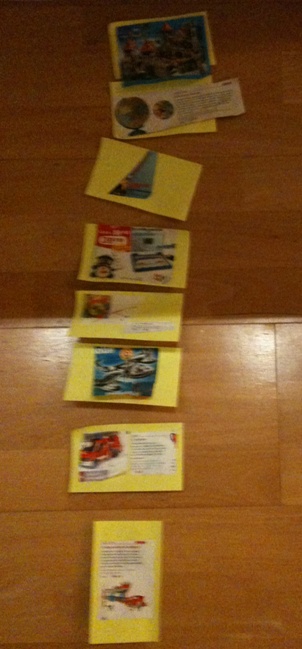
the list of items is prioritized
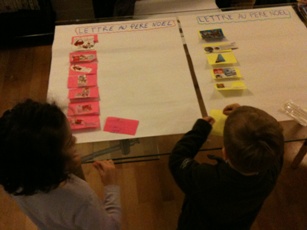
From the floor to the table
Step 4: Backlog Customization
Notes are now prioritized on the ground. We keep the principle of visual management but our product owner wish this year to customize their backlog.

- Final Backlog – Girl version
Step 5 : Backlog display
Go to the room for an optimal visibility

Visual management... In situ !
Results
We really had a great time and the children enjoyed it. They’re very very happy. And you know what ? … It was a pleasure to coach such good Product Owners 🙂


















